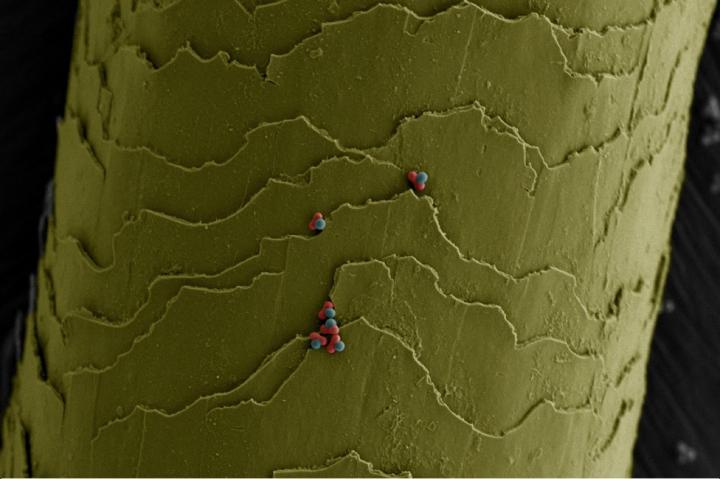Tiny transformers: Chemists create microscopic and malleable building blocks

A team of NYU chemists has created malleable and microscopic self-assembling particles that can serve as the next generation of building blocks in the creation of synthetic materials. The research focused on engineering particles a micrometer in width -- about 1/200th the width of a strand of human hair (on which the particles [pink and blue] are placed in the above image). Image courtesy of the Sacanna lab.
“Our work turns the tiniest of particles from inflexible, Lego-like pieces into ones that can transform themselves into a range of shapes,” explains Stefano Sacanna, an assistant professor in NYU's Department of Chemistry and the senior author of the paper, which appears in the journal Nature Communications. “With the ability to change their contours, these particles mimic alterations that occur in nature.”
The research focused on engineering particles a micrometer in width–about 1/200th the width of a strand of human hair.
Specifically, it aimed to enhance the adaptability of colloids–small particles suspended within a fluid medium. Such everyday items such as paint, milk, gelatin, glass, and porcelain are composed of colloidal dispersions, but it's their potential to control the flow of light that has scientists focused on creating exotic colloidal geometries.
By triggering specific morphological changes in the singular colloidal unit, the Sacanna group hopes to advance colloidal crystal engineering.
The scientists discovered that, much like Gulliver tied down by Lilliputians, metallic particles encased in oil droplets were tethered by many chemical bonds. Breaking those tethers via a photocatalytic reaction–in which the absorption of light spurs a chemical response–caused the metallic particle to free itself, producing an overall shape change. In other words, shining a light on a simple crystal allowed the scientists to create a material that transforms its microstructure.
###
The study's other authors were: Mena Youssef and Theodore Hueckel, both NYU doctoral students, and Gi-Ra Yi, a professor at South Korea's Sungkyunkwan University.
This work was supported by the MRSEC Program of the National Science Foundation (DMR-1420073).
Media Contact
All latest news from the category: Life Sciences and Chemistry
Articles and reports from the Life Sciences and chemistry area deal with applied and basic research into modern biology, chemistry and human medicine.
Valuable information can be found on a range of life sciences fields including bacteriology, biochemistry, bionics, bioinformatics, biophysics, biotechnology, genetics, geobotany, human biology, marine biology, microbiology, molecular biology, cellular biology, zoology, bioinorganic chemistry, microchemistry and environmental chemistry.
Newest articles

A universal framework for spatial biology
SpatialData is a freely accessible tool to unify and integrate data from different omics technologies accounting for spatial information, which can provide holistic insights into health and disease. Biological processes…

How complex biological processes arise
A $20 million grant from the U.S. National Science Foundation (NSF) will support the establishment and operation of the National Synthesis Center for Emergence in the Molecular and Cellular Sciences (NCEMS) at…

Airborne single-photon lidar system achieves high-resolution 3D imaging
Compact, low-power system opens doors for photon-efficient drone and satellite-based environmental monitoring and mapping. Researchers have developed a compact and lightweight single-photon airborne lidar system that can acquire high-resolution 3D…





















